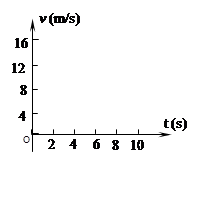问题
计算题
小汽车甲以8m/s的速度在平直的公路上向右匀速行驶。某时刻,发现在其正前方20m处,有一货车乙刚好以2m/s2的加速度由静止开始向右做匀加速直线运动,且当乙车速度达到12m/s时,便保持此速度匀速运动,而甲车继续匀速运动。
(1) 求乙车速度增加到8m/s所用的时间
(2)判断甲车能否追上乙车?若能追上,求出追上时所用的时间;若不能追上,求出甲、乙之间的最小距离
(3)请在图11中画出0~8s内甲、乙两车的速度v与时间t的图像
答案
(1)4s(2)追不上,最近距离4m(3)见答案解析
题目分析:(1)
(2)乙车速度达到8m/Ss时,运动的位移大小为:

此时,甲运动的位移大小为

因为甲、乙运动的位移差为

所以,甲车不能追上乙车,且此时的距离就是最小距离
其最小距离为
其它解法只有合理同样得分
(3)如图所示

点评:本题通过匀变速直线运动规律的相关公式求解追击问题,本题可以列出方程,通过数学一元二次方程的判别式计算的答案的个数。
